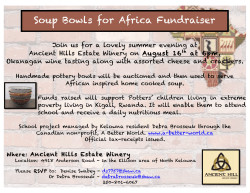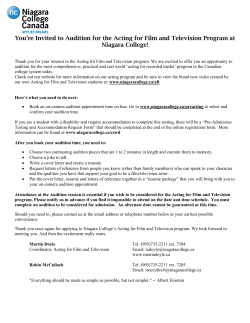
Writing a Winning resumé Think ahead. Go further.
career centre Writing a Winning Resumé Think ahead. Go further. What’s the purpose of a resumé? • To convince the employer that you have what it takes to be successful in the position • To inspire the employer to pick up the phone and set up an interview with you While your resumé is a vital step in the job search process, it is important to keep in mind that it is only one part of a package. Self-knowledge, interview preparation, networking, and follow-up are also essential to your job search success. Before you start building your resumé, be sure that you have done a lot of self-exploration. Know who you are, what you want, and what you have to offer. What guidelines should I follow when creating my resumé? • The first impression of your resumé is the most important. Have someone else read over your resumé to check for grammatical and spelling errors. Although format and style do count, it is the actual content and your ability to create interest that encourages the employer to interview you. It doesn’t matter how fancy your resumé is if the quality of the content is missing. • Each resumé should be tailored to the employer’s needs as much as possible. Look at the requirements of the job, and highlight only the relevant qualifications on your resumé. If you have a lot of work experience, it is best to list only three or four of your previous jobs. • Focus on your skills, personal qualities, achievements, and quantifiable accomplishments using past tense verbs (e.g., created, led, initiated). »»See the “Marketing ‘Me Inc.’” handout for powerful action verbs to describe your activities and a list of sample accomplishment statements. • A resumé is a summary of your experience and should be kept to two pages. • Make points that are concise and have impact (i.e., do not use paragraphs). Use bullets to focus on points. Constantly ask yourself, “How will adding this piece of information get me an interview?” If the answer is “it doesn’t,” then leave it out. • List the most important points first when organizing your headings and content. • Include a cover letter when you present a resumé to an employer. »»See the “Crafting a Cover Letter” handout for some great tips on creating cover letters that employers will notice. • When faxing or emailing your resumé to an employer, follow up whenever possible by sending an original. • Print your resumé on good bond paper (typically white or off-white) and use only one side of the page. Your cover letter should be printed on the same type of paper as your resumé. • Be honest. You should make the most of your experience and achievements, but do not mislead the employer or give information you are not able to justify in an interview. What should I include in a combination resumé? Are there different kinds of resumés? • Basic resumé types include chronological, functional, and combination types. • The one you choose will depend on the industry and the position for which you are applying. • The combination type is popular with most employers, as it reveals your unique skills and shows your history to back it up. Although it takes more time to design, format, and write, the combination style combines the advantages of all formats. • Do not add fuzzy phrases or clichés which are obvious or do not mean anything Summary of strengths and skills • List several points highlighting your strengths and skills that are pertinent to the position • Briefly target essential information that you will elaborate on in the following sections Education • If you have no relevant work experience, education should be emphasized first (if you have some relevant experience, the education section should follow the work experience section) • Education should be in reverse chronological order, starting with your most recent degree (or the degree for which you are working towards completion) • High school details are optional • On the first page, include your name, address(es), telephone number, and email • Include special course work, clinical placements, thesis details, or extra certification that is particularly suited to the employer’s needs • On the second page, include your name and the page number • Mention grades if they are noteworthy (e.g., honours student, Dean’s list, etc.) o not include personal data such as age, gender, D marital status, social insurance number, or health status, or a photograph Awards (optional) Profile statement • If you have earned only one or two awards, list these in the Education section with the related details Contact information • Make this brief, unique, and matched to the job/company/organization for which you are applying – tell them a bit about who you are • Include honours, citations, scholarships, passport to education, and any other recognition Writing a Winning Resumé Work/related/other/volunteer experience • List your experiences in reverse chronological order (i.e., start with your most recent position first) • For each position: »»List your position title, company, and dates of employment »»Include your accomplishments and key responsibilities • Work experience can be divided in several ways, or included under one heading, depending on the amount of each How should I format my resumé? • When creating your resumé, keep in mind the following techniques: • Contrast: Use formatting like bold or underlined font to make your headings, degree, and job titles stand out from the regular text. An employer should not have to spend time figuring out the difference between headings and the rest of your resumé text. • Repetition: Carry visual elements of the design through the resumé. For example, if you choose to make one heading bold, underlined, and capitalized, do the same with all the headings. Extracurricular activities and interests (optional) • Employers are interested in your accomplishments beyond your academic achievements • Things to include might be: on-campus clubs you belong to (be sure to include any positions you may have held), activities that demonstrate communication ability (e.g., Toastmasters), any team sports you participate in and to what level you achieved success in a sport, participation in a band or musical group • Be sure you know why you are including this information and how the activity benefits or would be of interest to the employer ubc career cycle Connect and assess Know yourself Focus your action plan Explore options • Alignment: Nothing should be placed on the page arbitrarily. For example, don’t use one alignment for headings (flush left) and one alignment for other text. • Proximity: Items that are related to one another should be grouped close together, as this helps to organize information and reduces clutter. For detailed information on principles of layout and design, consult Robin Williams’ The NonDesigner’s Design Book. Content adapted from UBC Career Services, Vancouver campus References • Do not include references on your resumé, unless the employer asks for them explicitly • Prepare a separate reference sheet and make sure you leave a copy with the interviewer • Include each reference’s name, address, phone numbers, position, and place of employment • The ideal number of references is three. The best references are previous supervisors from past work and volunteer experiences. Second best are professors, TAs, or anyone who has had an opportunity to review your work. Third best are personal references such as friends of family. The University of British Columbia Career Centre Okanagan University Centre 207 3333 University Way Kelowna BC V1V 1V7 www.ubc.ca/okanagan/students/careers Sample resumé Sara January 123 Hall Drive Kelowna, BC V7V 1V7 250.555.1111 sarajan@hotmail.com PROFILE Dedicated environmental educator, experienced in leading and inspiring youth to attain conservation and self-esteem goals. HIGHLIGHTS OF QUALIFICATIONS • Three summers of experience leading outdoor programs for children • BSc, Biology major, Environmental Sciences minor (May 2006) • A nature nut with a contagious enthusiasm for environmental appreciation and preservation • Skilled at designing activities to capture and maintain children’s attention • First Aid certification EDUCATION BSc, Biology major, Environmental Sciences minor, ubc May 2006 RELATED EXPERIENCE AND ACCOMPLISHMENTS Educator (volunteer) Evergreen Foundation, Kelowna, bc Sep 2001–present • Planned and implemented public education and fundraising events for a non-profit that promotes pollution reduction. • Promoted Evergreen’s programs and services by distributing information and literature to over 1,000 people at the Kelowna Green Day Conference. • Increased public awareness on issues of recycling and air pollution by talking with potential donors during 15 fundraising events. Exceeded our fundraising goals by 10% last year. Day Camp Leader ywca, Kelowna bc Jun–Aug 2005 • Coached summer day camps for youth ages 7–10. Led activities such as hiking, kayaking, and orienteering. • Connected children to nature by creating an innovative, week-long “Hug a Tree” program where children adopted and cared for a tree. 65% of participants ranked this as their favourite activity in evaluations. • Enriched children’s summer experiences by designing activities that were fun, interactive, and educational. Camp Counsellor Big Cove Camp, Lake Country bc Jun–Aug, 2003 & 2004 • Planned and coordinated activities for a group of inner-city youth, ages 12–14. • Camp mandate was to improve troubled youth’s self esteem through outdoor pursuits. • Improved participation of minority and marginalized children by creating an introduction game called “Guess my Gift,” which my supervisor noted as an outstanding contribution during our year-end celebration. • Expanded camp’s swimming and boating programs by 30% by developing and delivering a beginner’s water safety class. OTHER EXPERIENCE Customer Service Representative Sears, Kelowna bc Mar–Sep 2002 • Maintained customer satisfaction by offering personable, efficient service with a smile. EXTRACURRICULAR ACTIVITIES bc Federation of Mountain Clubs, member 2001–present ubc Debating Team, member Sep–Mar 2002 Kayaking, hiking, swimming
© Copyright 2025











